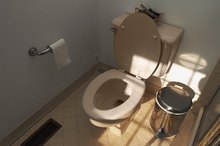Causes of White Blood Cells in Urine
Conditions affecting your urinary tract can make daily tasks uncomfortable. Urine is normally sterile and does not contain blood cells. The presence of white blood cells -- WBCs -- in a urine sample indicates an abnormal condition within the urinary tract or kidney. The kidney, bladder and other parts of the urinary tract may become inflamed or infected.
If you are experiencing serious medical symptoms, seek emergency treatment immediately.
Urinary Tract Infection
A urinary tract infection -- UTI -- is a common cause of WBCs in urine. Bacteria enter the urethra and travel up to the bladder, causing cystitis -- an infection of the bladder 2. Women have shorter urethras than men, making women more prone to these infections. In men, infection may start in the prostate and move up into the bladder, causing cystitis. Symptoms of UTI include urinary frequency, bladder spasms, urgency to urinate every few minutes and pain just above the pubic bone. Antibiotics are typically used to treat UTIs.
- A urinary tract infection -- UTI -- is a common cause of WBCs in urine.
- In men, infection may start in the prostate and move up into the bladder, causing cystitis.
Interstitial Cystitis
What Are the Causes of Painful Ejaculation?
Learn More
Unlike UTI, interstitial cystitis is not caused by infection. White blood cells in the urine are caused by inflammation of the bladder wall. IC is more common in women than men, and causes urinary urgency, frequency and pelvic pain. This condition is treated with oral medications to protect the mucous lining of the bladder, reduce inflammation, adjust hormone levels and reduce pain. If conservative treatment is not successful, surgery may be required.
- Unlike UTI, interstitial cystitis is not caused by infection.
- This condition is treated with oral medications to protect the mucous lining of the bladder, reduce inflammation, adjust hormone levels and reduce pain.
Pyelonephritis
Pyelonephritis -- infection of the kidney -- can cause WBCs in your urine. Symptoms of pyelonephritis may include severe pain, fever, malaise, nausea and vomiting. This condition is caused by bacterial or viral infections, and is typically treated with antibiotics. Pyelonephritis affects people of all ages, but is more common in women.
- Pyelonephritis -- infection of the kidney -- can cause WBCs in your urine.
- Symptoms of pyelonephritis may include severe pain, fever, malaise, nausea and vomiting.
Kidney Stones
What Are the Consequences of an Untreated UTI?
Learn More
Kidney stones impede the passage of urine in the urethra. As a result, urine stagnates, increasing risk of bacterial infection. Irritation of the urethra from these stones may also cause WBCs in your urine. Kidney stones cause severe pain that may come in waves, making it difficult for you to stay in one position. If the stone is blocking the urethra, it may be difficult to urinate or you may urinate only small amounts at a time. Bladder spasms and pain during urination may also occur. People who have had one kidney stone are more likely to have more. If the stones are too large to pass through your urinary tract, they can be broken up with ultrasound or surgically removed.
- Kidney stones impede the passage of urine in the urethra.
- Kidney stones cause severe pain that may come in waves, making it difficult for you to stay in one position.
Related Articles
References
- BMC Family Practice: Does Clinical Examination Aid in the Diagnosis of Urinary Tract Infections in Women? A Systematic Review and Meta-Analysis
- Therapeutic Advances in Urology: Role of Inflammation in Bladder Function and Interstitial Cystitis
- BMC Nephrology: The Clinical and Imaging Presentation of Acute "Non Complicated" Pyelonephritis -- A New Profile for an Ancient Disease
- Expert Opinion on Pharmacotherapy: Kidney Stones -- An Update on Current Pharmacological Management and Future Directions
- Cleveland Clinic. Painful urination.
- Mayo Clinic. Painful urination.
- Bent S, Nallamothu BK, Simel DL, Fihn SD, Saint S. Does this woman have an acute uncomplicated urinary tract infection?. JAMA. 2002;287(20):2701-10. doi:10.1001/jama.287.20.2701
- Coker TJ, Dierfeldt DM. Acute Bacterial Prostatitis: Diagnosis and Management. Am Fam Physician. 2016;93(2):114-20.
- Michels TC, Sands JE. Dysuria: Evaluation and Differential Diagnosis in Adults. Am Fam Physician. 2015;92(9):778-86.
- Devillé WL, Yzermans JC, Van duijn NP, Bezemer PD, Van der windt DA, Bouter LM. The urine dipstick test useful to rule out infections. A meta-analysis of the accuracy. BMC Urol. 2004;4:4. doi:10.1186/1471-2490-4-4
- Cleveland Clinic. Painful urination.
- Mayo Clinic. Painful urination.
- McAninch JW. Symptoms of disorders of the genitourinary tract. In: Tanagho EA, McAninch JW (eds) Smith’s General Urology. 17th ed. New York: McGraw Hill, 2008.
Writer Bio
A registered nurse with more than 25 years of experience in oncology, labor/delivery, neonatal intensive care, infertility and ophthalmology, Sharon Perkins has also coauthored and edited numerous health books for the Wiley "Dummies" series. Perkins also has extensive experience working in home health with medically fragile pediatric patients.









